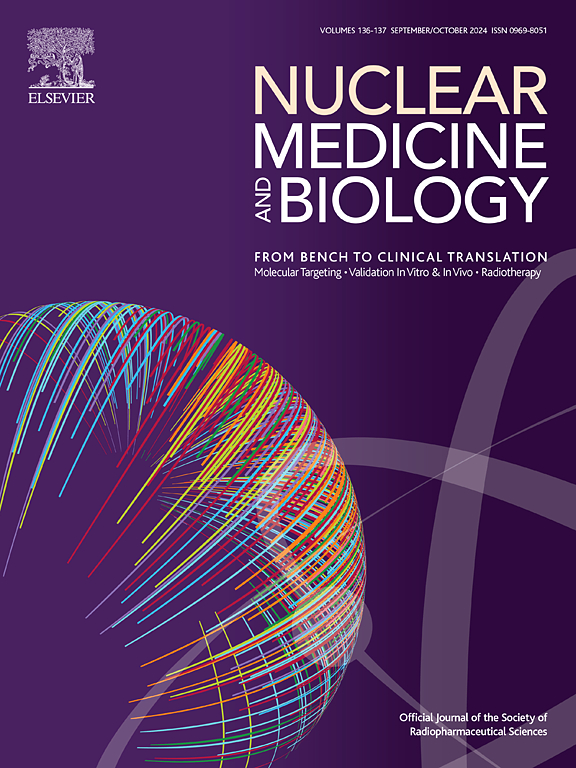ImmunoPET for mesothelin positive tissues using bio-orthogonal in-vivo click chemistry
IF 3
4区 医学
Q1 RADIOLOGY, NUCLEAR MEDICINE & MEDICAL IMAGING
引用次数: 0
Abstract
Mesothelin is a membrane bound antigen overexpressed in a wide array of cancers including ovarian, pancreatic, lung, and triple negative breast cancers. Here a full-length IgG antibody developed against mesothelin, called MESO-HSS1 was conjugated for immunoPET imaging and assessed in-vivo in a H956 mesothelin positive model. Furthermore, random lysine conjugation as well as a site selective conjugation method were compared in two pretargeting models for overall tumor uptake alongside non target organs and tumor to organ ratios. Overall, [89Zr]Zr-DFO-MESO-HSS1 was found to be a suitable immunoPET radiotracer for the detection of the mesothelin low cancer line H596 as early as 24 h post injection with up to 20.1 % injected dose per gram by 144 h. Furthermore, in pretargeted models, lysine conjugation of TCO-Lys-MESO-HSS1 with [64Cu]Cu-Sar-Tz yielded the highest tumor uptake at 2.6 % injected dose per gram at 24 h. Imaging 4 h post injection of [18F]F-Al-NOTA-PEG7-Tz however was best with TCO-SS-MESO-HSS1 with improved tumor to organ ratios as expected from site selective modifications. High tumor to pancreas ratios suggests mesothelin imaging could be a highly effective diagnostic for pancreatic cancer identification. Together these data show MESO-HSS1 as a direct immunoPET or pretargeting agent as a viable immunoPET system for imaging mesothelin positive cancers.

使用生物正交体内点击化学免疫pet检测间皮素阳性组织
间皮素是一种膜结合抗原,在多种癌症中过表达,包括卵巢癌、胰腺癌、肺癌和三阴性乳腺癌。在这里,针对间皮素开发的全长IgG抗体MESO-HSS1被偶联用于免疫pet成像,并在H956间皮素阳性模型中进行体内评估。此外,随机赖氨酸偶联和位点选择性偶联方法在两种肿瘤摄取与非靶器官和肿瘤与器官比例的预靶向模型中进行了比较。总体而言,[89Zr]Zr-DFO-MESO-HSS1被发现是一种合适的免疫pet示踪剂,可在注射后24小时检测间皮素低癌细胞株H596, 144小时注射剂量高达20.1% /克。此外,在预靶向模型中,赖氨酸偶联TCO-Lys-MESO-HSS1与[64Cu]Cu-Sar-Tz在24小时内产生了最高的肿瘤摄取,注射剂量为每克2.6 %。然而,注射[18F]F-Al-NOTA-PEG7-Tz后4小时的成像效果最好,与TCO-SS-MESO-HSS1结合后,肿瘤与器官的比例得到改善,正如位点选择性修饰所预期的那样。高肿瘤与胰腺比值提示间皮素成像可能是胰腺癌鉴别的高效诊断。综上所述,这些数据表明MESO-HSS1作为一种直接的免疫pet或预靶向剂作为一种可行的免疫pet系统用于间皮素阳性癌症的成像。
本文章由计算机程序翻译,如有差异,请以英文原文为准。
求助全文
约1分钟内获得全文
求助全文
来源期刊

Nuclear medicine and biology
医学-核医学
CiteScore
6.00
自引率
9.70%
发文量
479
审稿时长
51 days
期刊介绍:
Nuclear Medicine and Biology publishes original research addressing all aspects of radiopharmaceutical science: synthesis, in vitro and ex vivo studies, in vivo biodistribution by dissection or imaging, radiopharmacology, radiopharmacy, and translational clinical studies of new targeted radiotracers. The importance of the target to an unmet clinical need should be the first consideration. If the synthesis of a new radiopharmaceutical is submitted without in vitro or in vivo data, then the uniqueness of the chemistry must be emphasized.
These multidisciplinary studies should validate the mechanism of localization whether the probe is based on binding to a receptor, enzyme, tumor antigen, or another well-defined target. The studies should be aimed at evaluating how the chemical and radiopharmaceutical properties affect pharmacokinetics, pharmacodynamics, or therapeutic efficacy. Ideally, the study would address the sensitivity of the probe to changes in disease or treatment, although studies validating mechanism alone are acceptable. Radiopharmacy practice, addressing the issues of preparation, automation, quality control, dispensing, and regulations applicable to qualification and administration of radiopharmaceuticals to humans, is an important aspect of the developmental process, but only if the study has a significant impact on the field.
Contributions on the subject of therapeutic radiopharmaceuticals also are appropriate provided that the specificity of labeled compound localization and therapeutic effect have been addressed.
 求助内容:
求助内容: 应助结果提醒方式:
应助结果提醒方式:


